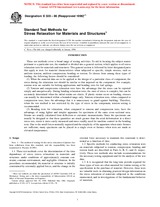We need your consent to use the individual data so that you can see information about your interests, among other things. Click "OK" to give your consent.
ASTM E328-86(1996)e1
Standard Test Methods for Stress Relaxation Tests for Materials and Structures (Includes all amendments And changes 8/16/2017).
Automatically translated name:
Standard Test Methods for Stress Relaxation Tests for Materials and Structures
STANDARD published on 1.1.1996
The information about the standard:
Designation standards: ASTM E328-86(1996)e1
Note: WITHDRAWN
Publication date standards: 1.1.1996
SKU: NS-46420
The number of pages: 12
Approximate weight : 36 g (0.08 lbs)
Country: American technical standard
Category: Technical standards ASTM
Annotation of standard text ASTM E328-86(1996)e1 :
Keywords:
Castings, Compression testing-metallic materials, Cracking-stress-cracking, Elongation-metallic materials, Extensometers, Gaskets, Humidity, Joints, Loading tests-metals/alloys, Metals and metallic materials, Metals and metallic materials-inclusion rating, Notches, Plastics (general), Springs, Strain testing, Stress relaxation tests, Structural analysis, Tension (tensile) properties/tests-metallic materials, Welding/welds, stress relaxation (materials/structures), test,, Forgings-general
Additional information
| 1. Scope | ||||||||||||||||
|
1.1 These test methods cover the determination of the time dependence of stress (stress relaxation) in materials and structures under conditions of approximately constant constraint, constant environment, and negligible vibration. In the procedures recommended, the material or structure is initially constrained by externally applied forces, and the change in the external force necessary to maintain this constraint is determined as a function of time. 1.2 Specific methods for conducting stress relaxation tests on materials subjected to tension, compression, bending and torsion loads are described in Parts A, B, C, and D, respectively. These test methods also include recommendations for the necessary testing equipment and for the analysis of the test data. 1.3 It is recognized that the long time periods required for these types of tests are often unsuited for routine testing or for specification in the purchase of material. However, these tests are valuable tools in obtaining practical design information on the stress relaxation of materials subjected to the conditions enumerated, and in investigations of the fundamental behavior of materials. 1.4 This standard does not purport to address the safety problems associated with its use. It is the responsibility of the user of this standard to establish appropriate safety and health practices and determine the applicability of regulatory limitations prior to use. |
||||||||||||||||
| 2. Referenced Documents | ||||||||||||||||
|



 Cookies
Cookies
